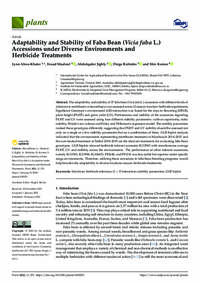Adaptability and Stability of Faba Bean (Vicia faba L.) Accessions under Diverse Environments and Herbicide Treatments

Authors:
The adaptability and stability of 37 faba bean (Vicia faba L.) accessions with different levels of tolerance to metribuzin or imazethapyr was assessed across 12 season–location–herbicide experiments. Significant Genotype x environment (GE) interaction was found for the days to flowering (DFLR), plant height (PLHT) and grain yield (GY). Performance and stability of the accessions regarding PLHT and GY were assessed using four different stability parameters: cultivar superiority, static stability, Wricke’s eco-valence and Finlay and Wilkinson’s regression model. The stability parameters ranked these genotypes differently suggesting that PLHT and GY stability should be assessed not only on a single or a few stability parameters but on a combination of them. GGE biplot analysis indicated that the environments representing metribuzin treatment at Marchouch 2014–2015 and the non-treated treatment at Terbol 2018–2019 are the ideal environments for evaluating faba bean genotypes. GGE biplots showed herbicide tolerant accession IG12983 with simultaneous average PLHT, GY and stability across the environments. The performance of other tolerant accessions, namely IG13945, IG13906, IG106453, FB2648, and FB1216 was less stable but superior under specific mega environments. Therefore, utilizing these accessions in faba bean breeding programs would help broaden the adaptability to diverse locations–season–herbicide treatments.
